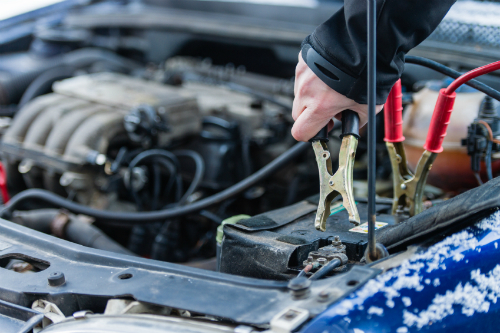How to Jump Start a Car
If you haven’t personally been stuck with a dead car, you probably know someone who has. It happens quite often, you leave a light on unknowingly, and come back to a lifeless battery. If you don’t have roadside assistance, then this tiny issue can turn into a big one quickly, especially if you don’t know how to jump start a car.
Below we’ll explain how to jump start a vehicle, and tips on what backup plans you should consider investing in. So, if you ever walk out to a dead battery, at least you’ll know what to do!
Have a Backup Plan in Place
Roadside Assistance
Investing in a roadside assistance plan through your auto insurance company is a great way to ensure any issues you face will be handled. If you have a new driver in your family, you may want to consider putting them on a plan, so there’s always someone on call who can help them with a dead battery or any other issues.
Emergency Car Kit
It’s always a good idea to have an emergency car kit. Your kit should include:
- Flares or triangle reflectors
- Jumper cables
- A quart or more of motor oil
- A gallon of coolant
- Blanket or space blanket
- Flashlight and extra batteries
- Tool kit with screwdrivers, pliers, adjustable wrench, pocket knife
Using Jumper Cables
Once you have your cables handy and a friend has agreed to let you use a working automobile to charge your dead battery, here are the steps to take:
- Park the two cars close together, but make sure they don’t touch. Then, turn both cars off.
- Connect the positive jumper cable (usually red) to the positive terminal on the “dead” battery. (Typically, the positive battery terminal is marked with a plus sign, while the negative is marked with a minus.) Make sure the positive cable does not touch anything metal except for the battery terminal.
- Connect the other end of the positive cable to the positive battery terminal on the vehicle providing the jump.
- Connect the negative cable (usually black) to the negative terminal on the vehicle providing the jump.
- Connect the other end of the negative cable to an exposed metal part of the vehicle with the dead battery. (Unpainted components like brackets, bolts, etc., provide the best ground).
- Start the “booster” vehicle and let the engine idle for a few minutes.
- Start the disabled vehicle. If it doesn’t start, you may need to check the cable connections. If the battery is a few years old or has been dead for a a few weeks, you may consider revving the engine a bit to speed up the charging process. If that doesn’t work, there may be some other problem with the car, and you’ll need a mechanic’s help.
- If the car with the dead battery starts up, let it run with the cables attached to both cars for at least 20 minutes.
- Remove the black (negative) cable from the ground on the previously disabled vehicle (vehicle is still running). Following the reverse order of the connecting process can help prevent sparking.
- Remove the other end of the negative cable from the battery of the vehicle providing the jump.
- Remove the positive cable from the battery of the vehicle providing the jump.
- Remove the positive cable from the previously disabled vehicle.
The jump is meant to restart the disabled vehicle, not to recharge the battery. So, it may be a good idea to put the jumped battery on a battery charger, which you can buy at an automotive store, as soon as possible to help ensure that it’s charged to full capacity. If you’re unsure about the long-term health of your battery, consult a mechanic or a professional at an automotive store for advice.
We hope you found this helpful! Remember, if you have a vehicle that doesn’t run, and you need it transported to a different location, contact us at Auto Transport 123!

